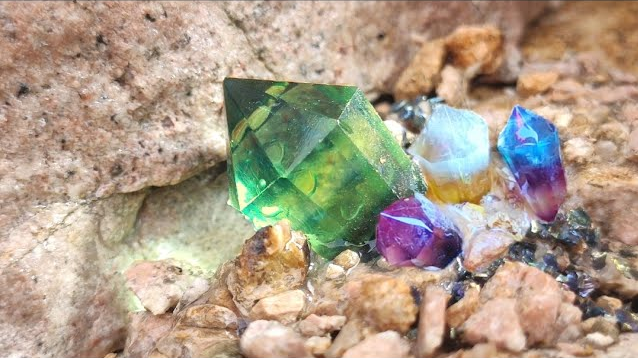Introduction
Multi-colored crystals with highly regular prismatic shapes are among the most captivating wonders of the mineral world. These natural marvels, prized by collectors and scientists alike, showcase the intricate beauty that emerges from the Earth’s geological processes. Let’s delve into what makes these crystals so remarkable, how they form, and why their vibrant colors and geometric precision continue to fascinate us.
What Are Prismatic Crystals?
Prismatic crystals are minerals that naturally grow into elongated, prism-like shapes. These prisms typically have well-defined faces and sharp edges, forming geometric patterns that seem almost too perfect to be natural. The regularity of these shapes is a result of the unique internal arrangement of atoms within each mineral species, a concept known as the crystal lattice.
Common examples of prismatic minerals include:
- Quartz: Often forms six-sided prisms with pointed ends.
- Tourmaline: Known for its long, multi-colored prismatic crystals.
- Beryl: Includes varieties like emerald and aquamarine, which grow in beautiful hexagonal prisms.
The Science of Color in Crystals
The multi-colored appearance of these crystals is a result of trace elements, impurities, or structural defects within the crystal lattice. Here’s how some crystals acquire their vivid hues:
- Tourmaline can display a rainbow of colors in a single crystal, often arranged in distinct zones or bands. This phenomenon is called color zoning.
- Beryl can appear green (emerald), blue (aquamarine), or pink (morganite) depending on the trace elements present.
- Quartz varieties like amethyst (purple) and citrine (yellow) gain their colors from iron or irradiation.
Iridescence and pleochroism—where crystals show different colors when viewed from different angles—also contribute to their visual appeal.
Formation and Growth
Crystal formation begins deep within the Earth, where heat, pressure, and the presence of mineral-rich fluids allow atoms to arrange themselves into repeating, symmetrical patterns. As these crystals grow:
- Slow cooling allows for larger, more perfect crystals to form.
- Stable conditions result in well-defined, regular prisms.
- Changing environments can cause color zoning or inclusions, adding to the uniqueness of each specimen.
Why Are They So Fascinating?
- Aesthetic Beauty: The blend of vivid colors and geometric regularity makes these crystals highly sought-after for jewelry, decoration, and artistic inspiration.
- Scientific Interest: Studying these crystals helps scientists understand the geological history of the Earth and the conditions that led to their formation.
- Metaphysical Appeal: Many people attribute spiritual or healing properties to multi-colored crystals, further enhancing their mystique.
Famous Examples
- Watermelon Tourmaline: Features a pink core and green outer rim, resembling a slice of watermelon.
- Rainbow Fluorite: Stacks bands of purple, green, blue, and clear in perfect cubes or prisms.
- Ametrine: A naturally occurring blend of amethyst and citrine, creating a striking purple-yellow prismatic crystal.
Conclusion
Multi-colored, highly regular prismatic crystals are a testament to nature’s artistry and the marvels of mineralogy. Whether admired as scientific specimens, treasures of the Earth, or objects of beauty, these crystals captivate us with their symmetry, color, and the stories they tell about our planet’s dynamic processes.
Curious about a specific crystal or want tips on collecting them? Feel free to ask!




